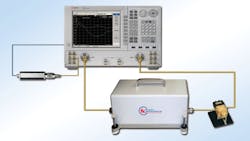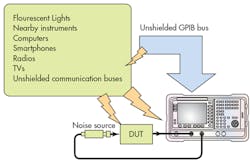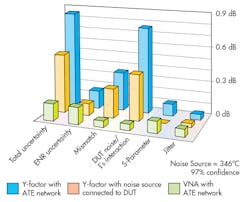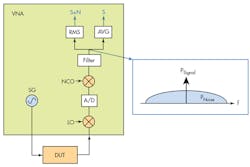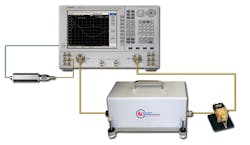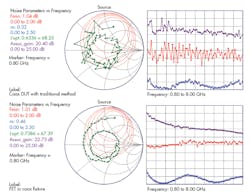6 Technologies and Techniques to Know for Measuring Noise Figure
This file type includes high resolution graphics and schematics when applicable.
In smartphone and portable-device use, Internet of Things (IoT) wireless sensor networks, and military networks, wireless radio technologies are breaking barriers in terms of throughput and low-power transmission and reception. Yet the effects of noise degradation scale with such performance extremes (Fig. 1). Historically, testing and characterizing the noise figure and noise parameters of the devices driving these applications has been both time-consuming and error-prone.
Such challenges are now being overcome by performance enhancements in recent test and measurement instruments; optional packages designed specifically for noise testing; and automation techniques. These developments are ushering in more efficient solutions for both noise-figure and noise-parameter testing. Knowledge of these methods and their implementation can aid in greater measurement accuracy and drastically reduced testing time.
1. Y-factor with noise source and spectrum/signal analyzer. The Y-factor method is one of the most common solutions for providing noise measurements. Essentially, this method uses a noise source connected to the device under test (DUT). The DUT, in turn, is connected at the input of an RF/microwave power-sensing device. With the noise source “on” and “off,” measurements of the signal power are taken over by a set bandwidth. The ratios of noise power in the “on” and “off” states are taken to generate the Y-factor.
With the excess noise ratio (ENR) specification provided by the noise-source manufacturer, the noise factor of the test system can be calculated next. Using knowledge of the DUT’s gain and the noise figure of the test-system components, it is then possible to extract and calculate the noise figure of the DUT.
To shorten noise-figure measurement times while increasing accuracy and repeatability, optional packages have been made available for several recent spectrum/signal analyzers. Companies such as Keysight, Tektronix, Anritsu, and Rohde & Schwarz offer options that include a software enhancement that guides an engineer through the measurements. Doing so ensures repeatability while automatically calculating the noise figure from the noise factor measurements.
Keep in mind that these measurements require calibrated noise sources with known ENR. Such sources are provided by companies like Noisewave, Keysight, Noisecom, Pasternack, and Mercury Systems.
When using spectrum/signal analyzers with very-low-power noise signals, a low-noise amplifier (LNA) will need to be added to the analyzer’s signal chain. Many of the companies that provide noise-figure options include low-noise preamplifiers for their spectrum/signal analyzers. Those preamplifiers are even built into the analyzer. With the internal preamplifier, measurement accuracy is increased while test-set component count and calibration complexity are reduced.
Many of the latest spectrum/signal analyzers reach 26.5 GHz and 43 GHz with a native analyzer from Rohde & Schwarz recently hitting 67 GHz. These analyzers allow noise measurements to be performed into the upper microwave and millimeter-wave bands without the need for external mixers. With external mixers, noise measurements to 110 GHz can be obtained with a spectrum/signal analyzer and the Y-factor method (Fig. 2).
2. The cold-source or gain solution. To characterize and measure noise figure, the cold-source solution employs a noise source held at a reference cold temperature, a network analyzer, and several step-calibration and gain measurements. A calibrated noise source is utilized to measure the noise figure of the instrument’s receiver while the network analyzer measures the DUT’s gain.
Once the prior measurements have been performed, the cold source can drive the DUT connected to the network analyzer. With the latest network analyzers with noise-figure packages, an additional pre-amplifier is often included inside the network analyzer. It enhances low-noise measurement capability (Fig. 3).
Similar to spectrum/signal analyzers with noise-figure packages, network-analyzer noise-figure packages often include software guides that aid in increasing test repeatability. With this method, the noise figure and S-parameters of a DUT can be measured in the same test setup. This aspect enhances the automation potential of the approach. An automated-test-equipment (ATE)-based setup could provide very rapid chip-and larger-device-level noise-figure testing. Obviously, automating the cold-source method could prove more repeatable and reliable than using multiple instruments and test setups.
Conveniently, software programs like MATLAB and LabView also include instrument-control and analysis toolboxes. These toolboxes enable the control and analysis of test instruments that can create complex and user-defined ATE systems. When coupled with ATE systems, software control and analysis tools enable the rapid and repeatable use of additional testing devices, such as impedance tuners, for optimizing the low-noise performance of non-50-Ω devices.
An example is finding the noise figure of unmatched transistors and low-noise amplifiers (LNAs). Here, the minimum noise-matching impedance can be found with an impedance tuner in conjunction with a cold-source, network-analyzer noise-figure measurement setup. Companies like Maury Microwave and Focus Microwaves offer impedance tuners, some of which are manual or automated. They can range from 2 to 26 GHz and 8 to 50 GHz for Maury Microwave tuner systems and from 100 MHz to 67 GHz for Focus Microwaves’ coaxial impedance tuners.
This file type includes high resolution graphics and schematics when applicable.
NFAs, VNAs, and More
This file type includes high resolution graphics and schematics when applicable.
3. Noise-figure analyzer/meter. Noise-figure analyzers (NFAs) are one-box solutions for Y-factor-based noise-figure measurements. In contrast to a noise-figure meter, spectrum analyzer, or network analyzer, an NFA is a dedicated instrument. Its control interface and display are designed specifically for noise-figure measurements. Currently, Keysight offers a series of NFAs from 3, 6.7, and 26.5 GHz. Using block downconverters, extensions to 110 GHz are possible.
NFAs have an added benefit of being equipped with an internal preamplifier. When seeking similar frequency and quality of measurement, an NFA is often the most cost-effective option—unless a spectrum/signal and network analyzers equipped with noise-measurement options are already available.
4. VNA-only noise-figure and S-parameter measurements. A VNA with direct receiver access and internal-generator step attenuators offers a highly flexible approach to noise-figure measurements. And it does so without an external calibrated ENR noise source and impedance tuner. The VNA-only setup uses the continuous-wave output of the VNA along with the direct-receiver access port (potentially with a built-in preamplifier) and several calibration steps to perform both noise-figure and S-parameter measurements.
Rohde & Schwarz provides an option to its ZVA network analyzers that enables a software walkthrough of the process, thereby eliminating errors and reducing uncertainty. Varying measurement setups are possible, depending upon the type of DUT under test (Fig. 4).
5. Rapid noise-parameter measurements. Noise-figure measurements may help to quantify, certify, or verify the noise response of a device under certain conditions. Yet the noise figure may not provide insight into the noise effects and contributors within a device. Deeper insight into noise generators and the way noise propagates through a device is needed to optimize a device for low noise or other performance factors. Such information may be gained by generating the noise parameters.
Yet this step often requires highly specialized hardware and long test times ranging from several hours to many days. Traditionally, a VNA, calibrated noise source, noise-figure analyzer, and an external tuner are all needed to test the noise response at each frequency under a series of source impedance points. This test significantly compromises frequency and impedance resolution for testing time (Fig. 5).
Recently, Keysight Technologies and Maury Microwave developed a test solution that is designed to significantly automate and shorten noise-parameter measurements. The solution uses Keysight’s PNA-X network analyzer with an integrated noise receiver option and a calibrated noise source together with Maury Microwaves’ impedance tuner and automated tuner-system software for noise-parameter measurements.
Test times for high-resolution noise-parameter measurements using this solution may reportedly be reduced by a factor of a few hundred. At the expense of additional testing time, it provides the opportunity to gain greater detailed noise-parameter responses by increasing the test resolution to a much finer degree.
6. Millimeter-wave noise-figure and noise-parameter measurements. As interest in imaging and millimeter-wave backhaul, 5G, and other wireless communications continues to grow, several companies have begun offering refined noise-figure and noise-parameter measurement systems that can reach beyond 100 GHz. Many spectrum/signal analyzers and network analyzers offer frequency operation to 26.5, 43, and 50 GHz.
Block downconverters and mixer solutions raise those noise-figure measurements to 100 and 110 GHz. For example, Rohde & Schwarz has released a spectrum/signal analyzer with a receiver response to 67 GHz. It can enable Y-factor noise-figure measurements into the millimeter waves without external mixers.
Notably, the addition of Maury Microwaves’ noise-receiver module to the automated noise-parameter test setup enables wideband noise-parameter measurements between 8 and 50 GHz. The noise-receiver module can reduce the second-stage noise figure caused by the internal noise receiver of the VNA by 5 to 6 dB. Without the noise-receiver module and external wideband impedance tuner, an external electronic calibration kit or the PNA-X’s built-in electronic tuner can be used to test noise parameters with less sensitivity. Yet this solution only serves devices with near-50- Ω impedances (Fig. 6).
Another millimeter-wave-capable example of the cold-source approach is Anritsu’s VectorStar VNA with a noise-figure option. In a standard configuration, the VectorStar exhibits dynamic-range performance to 142 dB. The standard model covers 70 kHz to 70 GHz. Enhancements for the analyzer can bring the native frequency response to 145 GHz in a broadband configuration. Regarding noise-figure measurements, the VNA with the noise-figure option can measure from 70 kHz to 125 GHz with an optimized noise receiver for measurements from 30 to 125 GHz.
The power output of the VNA reaches +14 dBm, which would aid in testing a wide range of DUTs with directivity, source-match, and load-match test-port performance to 50 dB. Additionally, hardware options are available to extend the VectorStar VNA to 1.1 THz. Note, however, that this configuration operates in different frequency bands as opposed to a complete broadband configuration.
References
Measure Noise Without A Calibrated Source
Noise-figure Measurement Accuracy - The Y-Factor Method
The Y-Factor Technique For Noise-figure Measurements
Noise-figure Measurement Without A Noise Source On A Vector Network Analyzer
Noise-figure Measurement With The National Instruments RF Signal Generator And RF Signal Analyzer
Signal Chain Noise-figure Analysis
10 Hints For Making Successful Noise-figure Measurements
This file type includes high resolution graphics and schematics when applicable.
About the Author
Jean-Jacques DeLisle
Jean-Jacques graduated from the Rochester Institute of Technology, where he completed his Master of Science in Electrical Engineering. In his studies, Jean-Jacques focused on Control Systems Design, Mixed-Signal IC Design, and RF Design. His research focus was in smart-sensor platform design for RF connector applications for the telecommunications industry. During his research, Jean-Jacques developed a passion for the field of RF/microwaves and expanded his knowledge by doing R&D for the telecommunications industry.
